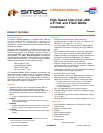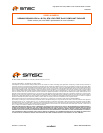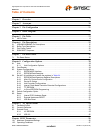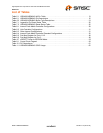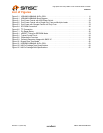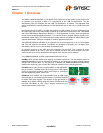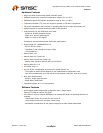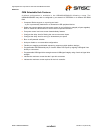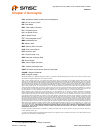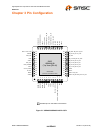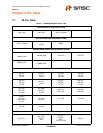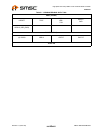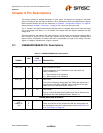
High Speed Inter-Chip USB 2.0 Hub and Flash Media Controller
Datasheet
SMSC USB4640/USB4640i 7 Revision 1.0 (06-01-09)
DATASHEET
Chapter 1 Overview
The SMSC USB4640/USB4640i is a Hi-Speed HSIC USB hub and card reader combo solution with
an upstream port compliant to HSIC 1.0, a supplement to the USB 2.0 specification. The two
downstream ports are compliant with the USB 2.0 specification. In addition, The dedicated flash
media reader/writer is internally attached to a 3rd downstream port of the hub as a USB Compound
device.
High Speed Inter-Chip (HSIC) is a digital interconnect bus that enables the use of USB technology
as a low-power chip-to-chip interconnect at speeds up to 480 Mb/s. Please refer to the “High-Speed
Inter-Chip USB Electrical Specification Revision 1.0 as of September 23, 2007” which can be found
at http://www.usb.org/developers/docs/docs. This combo solution supports today’s popular multi-
format flash media cards. This multi-format flash media controller and USB hub combo features two
exposed downstream USB ports available for external peripheral expansion.
The USB4640/USB4640i will attach to an upstream port as a Full-Speed hub or as a Full-/Hi-Speed
hub. The hub supports Low-Speed, Full-Speed, and Hi-Speed (if operating as a Hi-Speed hub)
downstream devices on all of the enabled downstream ports.
All required resistors on the USB ports are integrated into the hub. This includes all series
termination resistors on D+ and D– pins and all required pull-down and pull-up resistors. The over-
current sense inputs for the downstream facing ports have internal pull-up resistors.
The USB4640/USB4640i includes programmable features such as:
PortMap which provides flexible port mapping and disable sequences. The downstream ports of a
USB4640/USB4640i hub can be reordered or disabled in any sequence to support multiple platform
designs with minimum effort. For any port that is disabled, the USB4640/USB4640i automatically
reorders the remaining ports to match the USB host controller’s port numbering scheme.
PortSwap which adds per-port programmability to USB differential-
pair pin locations. PortSwap allows direct alignment of USB signals
(D+/D-) to connectors avoiding uneven trace length or crossing of
the USB differential signals on the PCB.
PHYBoost which enables four programmable levels of USB signal
drive strengths in downstream port transceivers. PHYBoost attempts
to restore USB signal integrity. The diagram on the right shows an
example of Hi-Speed USB eye diagrams before (PHYBoost at 0%)
and after (PHYBoost at 12%) signal integrity restoration in a
compromised system environment.



